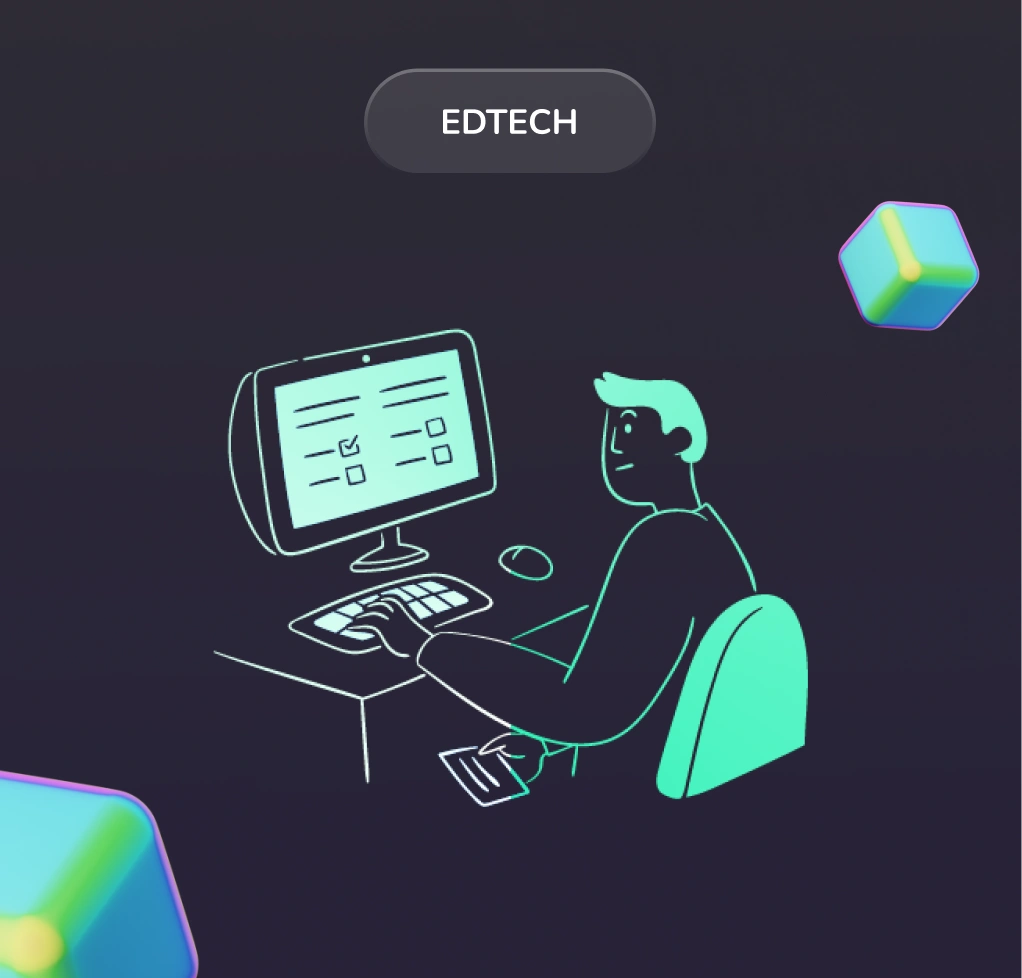Educational Technologies, or EdTech, refer to the use of digital tools, platforms, and innovations to enhance learning efficiency, making education more accessible, engaging, and personalized. Over the past decade, EdTech has significantly transformed global education by bridging gaps in traditional learning, promoting inclusivity, and equipping students and professionals with modern skills.
Today, understanding EdTech is crucial for business owners, as it presents valuable opportunities for investment, strategic partnerships, and innovative growth. So, let’s dive into this topic and explore the key trends in educational technology and emerging innovations shaping 2025 — without complex technical jargon, but with practical examples to help you navigate the evolving EdTech landscape.
The Current Landscape of Education Technology
Education is undergoing a remarkable transformation as technology becomes deeply integrated into learning environments, reshaping how students, professionals, and organizations approach knowledge acquisition. From online classrooms to AI-powered tutoring, the expansion of EdTech solutions is revolutionizing education, making learning more personalized, flexible, and accessible than ever before. This ongoing shift is reflected in the rapid growth of the EdTech industry, which is projected to exceed $400 billion by 2025, fueled by increasing demand for scalable and diverse learning solutions that cater to a variety of needs.
Online Learning Platforms Revolutionizing Education
Education technology trends are at the forefront of this transformation, with new educational technology continuously emerging to meet the needs of students, educators, and businesses. For instance, Coursera stands out as a global leader in online education trends, offering top-tier courses from universities like Yale and Stanford, making higher education accessible to millions of learners worldwide. Duolingo is another example of innovative technologies in education, using gamification and AI to create engaging language lessons that make learning both fun and effective, allowing users to practice at their own pace.
Meanwhile, Byju’s, a pioneer in adaptive learning, has successfully tapped into the growing demand for personalized learning. By using data-driven insights, Byju’s tailors its lessons to each student’s unique needs, ensuring a more customized and effective learning experience. This use of AI in education is a prime example of how education technology platforms are evolving to meet individual learning preferences, something that was previously unimaginable in traditional classroom settings.
These leading companies, among many others, are exemplifying the potential of EdTech innovations to dramatically alter how education is delivered. Whether through adaptive learning technologies, online education trends, or AI-driven educational tools, the current landscape of education technology is a testament to how rapidly these advancements are reshaping the education industry. As these technologies become more refined, they will continue to drive the future of EdTech, offering scalable and innovative solutions that improve learning outcomes across diverse sectors. EdTech products like Coursera, Duolingo, and Byju’s are just the beginning of a broader trend in education technology insights, marking the start of an exciting era for the future of technology in education.
Key EdTech Trends to Watch in 2025
The EdTech landscape in 2025 is set to be defined by a range of innovative technologies in education that are reshaping how both learners and educators interact with educational content. AI in education is one of the most significant driving forces, enabling highly personalized learning journeys that can adapt in real-time to the needs of each individual student. Tools like Khan Academy’s Khanmigo, an AI-powered tutor, and Quizlet, which leverages AI to create customized study plans, are revolutionizing how students engage with content, ensuring that each learner progresses at their own pace. Immersive technologies, particularly AR and VR, are rapidly transforming classrooms by offering interactive and dynamic learning experiences. Meta’s Horizon Workrooms allows for virtual collaboration, creating remote but engaging learning environments, while Google Expeditions takes students on virtual field trips to experience the world in new and exciting ways, making learning more hands-on and global.
Lifelong Learning, Gamification, and Data-Driven Education
In response to the demand for continuous development, EdTech platforms for lifelong learning are emerging to support workforce upskilling and personal growth. Udemy and LinkedIn Learning are expanding their offerings, helping business owners and employees alike to stay relevant in a rapidly evolving job market. Gamification is another essential trend driving engagement, as educational platforms like Minecraft Education Edition and Classcraft use game mechanics to make learning more fun and memorable. Data-driven decision-making is also playing a crucial role in improving educational outcomes. Platforms like PowerSchool and Schoology allow administrators and educators to analyze student data, make informed decisions, and optimize learning strategies for better results.
These emerging educational technologies are not just improving the way content is delivered but are also making education more accessible, personalized, and effective. As businesses, it’s crucial to stay attuned to these education technology trends and explore opportunities to integrate or partner with platforms that can help innovate and improve your educational offerings. By staying ahead of these new trends in educational technology, businesses can remain competitive in the ever-evolving EdTech industry, opening doors to disruptive innovation in education and contributing to the study evolution in EdTech.
Emerging Innovations in Education Technology
As EdTech continues to evolve, a wave of emerging educational technologies is redefining the future of learning. One key trend is the rise of e-learning technology trends like microlearning, which focuses on delivering bite-sized, easily digestible educational content. This approach caters to today’s fast-paced, on-the-go learners, making it easier to engage with material in short, focused bursts.
Microlearning and Corporate Training
Microlearning has become a key trend in corporate education and professional development, offering bite-sized, focused learning modules that improve engagement and knowledge retention. Tools like EdApp by SafetyCulture provide mobile-first learning solutions that make training more accessible for employees, allowing them to learn at their own pace, anytime and anywhere. These platforms include interactive quizzes, gamified lessons, and AI-driven learning paths, ensuring that corporate training remains effective and engaging. Companies implementing microlearning strategies benefit from higher productivity, lower training costs, and improved workforce skills, making it a crucial investment in the modern business landscape.
Smart Campuses and Learning Management Systems (LMS)
In higher education technology trends, the rise of smart campuses is transforming traditional learning environments. The integration of IoT (Internet of Things) devices with advanced learning management systems (LMS) like Canvas LMS enables real-time data tracking, automated administrative tasks, and personalized learning experiences. These education technology platforms help universities and colleges improve accessibility, communication, and student engagement, creating a seamless learning ecosystem. Features such as AI-powered analytics, predictive learning insights, and automated grading systems allow educators to focus more on teaching while technology handles the operational complexities.
Blockchain for Secure Credentialing
Blockchain technology is emerging as a disruptive innovation in education, offering secure and verifiable credentialing solutions. Companies like Learning Machine leverage blockchain to issue tamper-proof digital certificates, ensuring that student qualifications are authentic, easily accessible, and globally recognized. This has significant implications for businesses looking to verify employee qualifications, as well as for institutions that need to maintain compliance with industry regulations. Blockchain also enables lifelong learning records, allowing professionals to build a permanent, verifiable academic and skills portfolio that can be accessed across different industries and educational institutions.
Hybrid Learning Models and Virtual Classrooms
The future of education technology is increasingly defined by hybrid learning models, which blend traditional classroom experiences with digital learning tools. Platforms like Zoom Education and Google Classroom are at the forefront of this transformation, allowing for synchronous and asynchronous learning. These tools provide features such as virtual whiteboards, real-time collaboration, AI-powered transcription, and cloud-based resource sharing, making education more flexible and accessible. For businesses, hybrid learning offers an opportunity to train employees remotely, while educational institutions can ensure continuity of learning regardless of location or disruptions.
These innovations, powered by new educational technology and EdTech products, reflect the continuous study evolution in EdTech and underscore the importance of keeping pace with education industry trends. For business owners, it’s essential to recognize how these advancements can impact the way education is delivered and consider how they can integrate or partner with education technology platforms to offer more effective, scalable solutions. The future of EdTech is bright, driven by technologies that promise to improve both access to education and the quality of learning experiences for all.
The Future of Education and Technology
The future of education is shaping up to be more inclusive, personalized, and adaptable, thanks to emerging EdTech innovations and new educational technologies. As education trends continue to evolve, systems powered by AI in education will allow for adaptive learning experiences that cater to each student’s unique needs. By providing personalized educational pathways, these systems ensure that learners, regardless of their abilities or backgrounds, can thrive. This transformation will help break down barriers to education, promoting greater equitable access to high-quality learning, whether in urban or remote areas.
The Future of Smart Classrooms With AI and Robotics
Looking ahead, the future of technology in education promises to bring even more exciting changes. One key development is the rise of AI-powered teaching assistants, which will support educators by automating routine tasks such as grading and providing personalized feedback. This will enable teachers to focus more on fostering creativity, critical thinking, and higher-order skills among their students. Alongside AI, robotics will play a pivotal role in STEM education, providing interactive and hands-on learning experiences that help students better grasp complex concepts. As innovative technologies in education continue to advance, robots could become an integral part of the classroom, offering personalized assistance and practical applications.
Another major shift in the future of learning is the move towards flexible, borderless, and lifelong education opportunities. The future of EdTech will bring online education trends to the forefront, with learning platforms and content accessible anytime, anywhere. This flexibility will cater to the needs of an increasingly global workforce that demands continuous upskilling and reskilling to stay competitive.
E-learning technology trends are rapidly evolving to support this shift, ensuring that education can evolve into a lifelong journey rather than a one-time event. EdTech products such as online education platforms and education technology platforms will offer seamless learning experiences across devices, enabling learners to pursue professional development or personal growth at their own pace.
The education industry trends of the future will focus on empowering learners and educators with the right tools to stay relevant in a constantly changing world. This includes adopting disruptive innovation in education, such as blockchain for secure credentialing, and utilizing emerging educational technology like augmented and virtual reality to offer immersive, real-world simulations. As higher education technology trends move towards smart campuses and IoT integration, the learning environment will become more interactive, engaging, and data-driven, providing deeper insights into student progress and outcomes. The study evolution EdTech will empower educators with valuable tools to measure and improve learning strategies, ensuring a more effective educational experience for all.
Ultimately, the future of education technology promises an era where learning is more personalized, accessible, and integrated into our daily lives, making education technology insights more important than ever for business owners and educators alike. Whether for professional development or academic achievement, the future of EdTech is a dynamic and exciting field, filled with opportunities to create meaningful, lifelong learning experiences.
Challenges and Considerations for Businesses
As businesses venture into the EdTech space, navigating key challenges is essential for building sustainable and effective solutions. One of the most pressing concerns is data privacy. Education technology platforms often handle sensitive student and teacher data, making it vital for businesses to implement strict security measures to comply with global data protection regulations such as GDPR and FERPA. Companies must prioritize education technology insights on data security and ensure their platforms are equipped with strong encryption, user authentication, and transparent data usage policies to build trust and maintain regulatory compliance.
Another critical challenge is scaling EdTech solutions in regions with limited technological infrastructure. Current trends in education show that while EdTech is booming in developed areas, many parts of the world still face barriers like slow internet speeds or limited access to modern devices. To address these gaps, businesses must invest in innovative technologies in education, such as offline-first technology or lightweight applications that can function in low-bandwidth environments. This ensures that education technology platforms remain accessible to all students, regardless of their location or access to resources, aligning with the growing online education trends.
Balancing Technology and Human Connection in Education
While EdTech innovations like AI, virtual classrooms, and gamified learning are transforming education, businesses must also focus on maintaining a balance between human interaction and tech-based learning. One of the education industry trends is the shift towards personalized learning powered by AI, but it’s important not to let technology overshadow the crucial role of educators in fostering engagement and emotional connections. Businesses need to ensure that edtech products do not create a wholly impersonal educational experience. For instance, while AI can handle routine tasks like grading, human teachers should remain at the forefront of guiding, mentoring, and motivating students. Integrating technology while maintaining the teacher-student relationship will be crucial for creating a supportive and engaging learning environment.
Addressing these challenges and considerations is fundamental for businesses aiming to create disruptive innovation in education. By balancing technology and human interaction, ensuring privacy and security, and overcoming infrastructure challenges, companies can build EdTech solutions that are both impactful and scalable. With the future of education technology looking brighter with emerging tools and platforms, businesses that navigate these hurdles effectively will be well-positioned to lead the way in emerging educational technology and provide sustainable solutions for the next generation of learners.
Conclusion
As we look ahead to the future of education, several key EdTech trends stand out: the rise of AI-powered tools for personalized learning, the integration of immersive technologies like AR and VR, and the increasing importance of flexible, lifelong learning opportunities. Education technology insights show a clear shift toward personalized, accessible, and engaging learning experiences. To capitalize on these shifts, business owners should focus on identifying promising EdTech products that align with these emerging trends. Look for startups or platforms offering scalable, data-driven solutions that enhance the learning experience through adaptive technologies, immersive content, and user-friendly interfaces.
When considering integrating or partnering with education technology platforms, ensure they prioritize security, scalability, and the ability to personalize content to different learner needs. Education technology platforms that offer reliable, flexible, and innovative solutions will be the most likely to succeed in the evolving EdTech space. Lastly, as the future of technology in education continues to evolve, business owners are encouraged to explore opportunities in this dynamic field with confidence and adaptability. Embrace change, stay informed about new trends in educational technology, and consider how EdTech innovations can enhance your offerings, ensuring your business stays ahead in this rapidly growing industry.
FAQ
- What is education technology?
Brief definition and examples.
- What are the top trends in educational technology for 2025?
AI, AR/VR, gamification, hybrid learning, etc.
- What is the future of EdTech?
Emerging innovations and long-term predictions.
- How can business owners leverage education technology?
Tips for investment, collaboration, and scaling EdTech initiatives.
Subscribe to our blog

